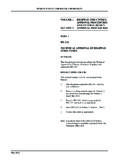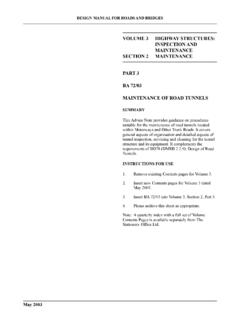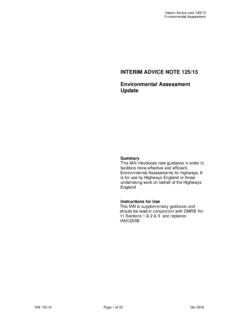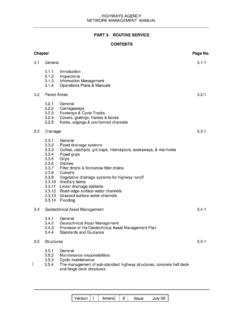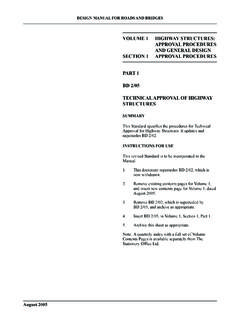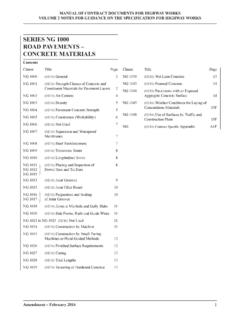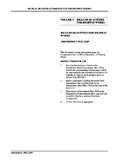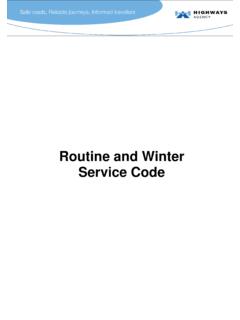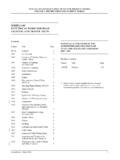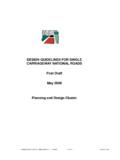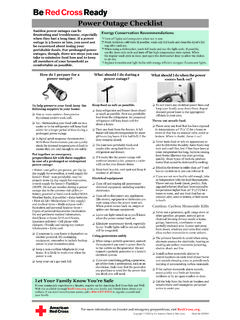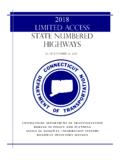Transcription of DMRB VOLUME 6 SECTION 1 PART 2 - TD 27/05 - …
1 February 2005 DESIGN MANUAL FOR ROADS AND BRIDGESVOLUME 6 road GEOMETRYSECTION 1 LINKSPART 2TD 27/05 cross -SECTIONS AND HEADROOMSSUMMARYThis Standard sets out the dimensional requirements forthe highway cross -sections for all-purpose andmotorway trunk roads, both at and away fromstructures. It also gives requirements for headroom FOR Contents pages from VOLUME 6 andinsert new Contents page for VOLUME 6 datedFebruary TD 27/96 from VOLUME 6, SECTION 1which is superseded by this Standard andarchive as TD 27/05 into VOLUME 5, SECTION archive this sheet as :A quarterly index with a full set of VolumeContents Pages is available separately from TheStationery Office Ltd.
2 TD 27/05 cross -Sections and HeadroomsSummary:This Standard sets out the dimensional requirements for the highwaycross-sections for all-purpose and motorway trunk roads, both at and awayfrom structures. It also gives requirements for headroom at MANUAL FOR ROADS AND BRIDGESTHE HIGHWAYS AGENCYSCOTTISH EXECUTIVEWELSH ASSEMBLY GOVERNMENTLLYWODRAETH CYNULLIAD CYMRUTHE DEPARTMENT FOR REGIONAL DEVELOPMENTNORTHERN IRELANDV olume 6 SECTION 1 Part 2 TD 27/05 February 2005 REGISTRATION OF AMENDMENTSA mendPage NoSignature & Date ofAmendPage NoSignature & Date ofNoincorporation ofNoincorporation ofamendmentsamendmentsRegistration of AmendmentsVolume 6 SECTION 1 Part 2 TD 27/05 February 2005 REGISTRATION OF AMENDMENTSA mendPage NoSignature & Date ofAmendPage NoSignature & Date
3 OfNoincorporation ofNoincorporation ofamendmentsamendmentsRegistration of AmendmentsVOLUME 6 road GEOMETRYSECTION 1 LINKSPART 2TD 27/05 cross -SECTIONS AND cross -Sections at at AFeatures Commonly Occurring in theHighway cross -SectionAnnex BRural Motorway Widening, cross -Sectionand Layout at Physical RestraintsDESIGN MANUAL FOR ROADS AND BRIDGESF ebruary 2005 VOLUME 6 SECTION 1 Part 2 TD 27/05 February 20051/1 Chapter 1 Introduction1. Standard sets out the design principles andfactors that should be considered by DesignOrganisations in selecting highway cross -sections andheadrooms.
4 The process of design is described togetherwith an approach to developing Standard supersedes TD 27/96. The majorchanges use of a modular system to describe theindividual components of the cross - SECTION ; acknowledgement that society demandsmeasures to permit better use of existing roads; guidance to encourage consideration offuture maintenance operations; widening of the road pavement in certaincircumstances for reasons of buildability and toaccommodate future traffic managementlayouts; on the need to fully consider andpromote facilities for non-motorised road users; way in which certain components of thecross- SECTION are measured.
5 Presentation of information has beenclarified and improved, with new Tables andadditional Figures; have been updated and extended:-guidance associated with reduced widthhardshoulders, central reserve and lanewidths to assist in the widening of ruralmotorways at short obstructions. SeeAnnex B; and-advice given on the provision of Standard gives details of thecross-sections and headrooms to be used for all-purposeand motorway trunk roads, both at and away information covers trunk roads of all types:rural motorways, rural all-purpose roads, urbanmotorways and urban all-purpose roads, together withassociated connector cross - SECTION of side roads that are not partof the Overseeing Organisation s network should beagreed with the relevant Highway Authority.
6 Furtherdetails are given in Chapter Standard is not applicable to road guidance see BD 78 ( dmrb ). details of pedestrian, cycle and equestriansubway dimensions see TD 36 ( dmrb ) andTA 91 ( dmrb ), for footbridges see BD 29( dmrb ), and for agricultural crossings see TA 5 7( dmrb ) and TA 56 ( dmrb ). standard does not give mandatoryrequirements for headroom near airports or at powerlines, but Annex A provides details of sources Standard must be used forthwith forthe design of all schemes for the construction andimprovement of all-purpose and motorway trunkroads currently being prepared, provided that in theopinion of the Overseeing Organisation, this wouldnot result in any significant additional expense ordelay.
7 The Design Organisation must confirm itsapplication to particular schemes with theOverseeing the definitions of the general highwayterms used in this Standard, such as highway types (trunk roads, motorway and all-purpose roads etc) andVolume 6 SECTION 1 Part 2 TD 27/05 February 20051/2 Chapter 1 Introduction components of the highway (hardshoulders,hardstrips and climbing lanes etc.), see BS 6100:Subsection terms used in this Standard aredefined as:Bridleway: Highway for use on foot or horseback(unless specifically prohibited, cyclists can also use abridleway but are required to give way to other users).
8 Berm: Any nominally flat area between the back of theverge and the highway boundary at the top of a cuttingor the bottom of an Reserve: The area that separates thecarriageways of a dual carriageway exclusive of road : Refer to TD 22 ( dmrb ). cross - SECTION : The assembly of the variouscomponents of the highway between the highwayboundaries, measured at right angles to the line of thehighway. The cross - SECTION includes carriageways,central reserve, separator zones, hardshoulders,hardstrips, verges including any footway, cycle track orbridleway, cutting or embankment slopes and berms.
9 (See Figure 4-1a to Figure 4-4b).CSRRS (Current Standard for road RestraintSystems): Please refer to the Overseeing Organisations current standard for road restraint systems. Note: Wherediagrams within TD 27 show vehicle restraint systems,these are for illustrative purposes only and the CSRRS must be consulted to determine the appropriateness ofany Lane: A lane in the carriageway for use Track: A track separate from the maincarriageway for use by Organisation: The organisation commissionedto undertake the various phases of scheme Lanes: A lane reserved exclusively for useby designated vehicles such as cycles, buses, taxis,large goods vehicles and high occupancy.
10 That part of the carriageway(s) wherethe traffic is flowing away from the cross - SECTION : The minimum distance between the surfaceof the highway cross - SECTION and the deflected structure(including any temporary or permanent attachments)measured at right angles to the surface of : Refer to TD 22 ( dmrb ).Interchange Link: Refer to TD 22 ( dmrb ).Loops: Refer to TD 22 ( dmrb ).Mainline: The carriageway carrying the main flow oftraffic (generally traffic passing straight through ajunction or interchange).Maintained Headroom: The minimum value ofHeadroom that must be preserved at all : EITHER the area between the Paved Widthand an NMU route OR an area between two parallelNMU routes OR an area between an NMU route and aphysical Construction Headroom: The value ofHeadroom for new structures that includes an additionalallowance for future road realignment and : Left-hand side of vehicle when viewing aforward moving vehicle from behind, typically thefront-seat passenger side of the vehicle in the Users (NMUs).
